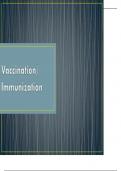,• Immunization is the means of providing specific protection
against most common and damaging pathogens.
• The mechanism of immunity depends on the location of the
pathogen and the mechanism of its pathogenesis.
• If the mechanism of pathogenesis involves exotoxins, the
only immune mechanism effective against it would be
neutralizing antibodies that would prevent its binding to
the appropriate receptor, while promoting its clearance
and degradation by phagocytes.
• Alternatively, if the pathogen produces disease by other
means, the antibody will have to react with the organism
and eliminate by complement-mediated lysis or
phagocytosis and intracellular killing.
,• However, if the organism is localized intracellularly, it will not
be accessible to antibodies while it remains inside.
• The cell harbouring it will have to be destroyed and only then
can antibody have any effect.
• Most viral infections and intracellular bacteria and protozoa
are examples of such pathogens.
• In this case, the harbouring cells can be destroyed by elements
of cell mediated immunity or, if they cause the infected cell to
express unique antigens recognizable by antibody, antibody-
dependent and complement mediated killing can expose the
organism to elements of humoral immunity.
• Alternatively, cells harbouring intracellular pathogen
themselves can be activated to kill the organism.
• Such is the case with pathogens that have the capability of
surviving within phagocytic cells.
,• There are 2 broad categories of immunisation: Active and
passive immunisation and both modes of immunization can
occur by natural or artificial processes.
• Active immunisation refers to immunity produced by the body
following exposure to antigens.
• Naturally acquired active immunity involves exposure to
different pathogens which leads to sub-clinical or clinical
infections, resulting in a protective immune response against
these pathogens.
• Artificially acquired active immunity may be achieved by
administering live or dead pathogens or their components and
is largely referred to as vaccination.
• Vaccines used for active immunization consist of live
(attenuated) organisms, killed whole organisms, microbial
components or secreted toxins (which have been detoxified).
,• Passive immunity refers to immunity that can be acquired
without the immune system being challenged with an antigen.
• This is done by transfer of serum or gamma-globulins from an
immune donor to a non-immune individual.
• Alternatively, immune cells from an immunized individual may
be used to transfer immunity.
• Naturally acquired passive immunity is Immunity that is
transferred from mother to foetus through placental transfer of
IgG or colostral transfer of IgA.
• Artificially acquired passive immunity refers to immunity that is
transferred by injection with gamma-globulins from other
individuals or gamma-globulin from an immune animal.
• Passive transfer of immunity with immune globulins or gamma-
globulins (antibodies) is practiced in numerous acute situations
of infections (diphtheria, tetanus, measles, rabies, etc.),
poisoning (insects, reptiles, botulism), and as a prophylactic
measure (hypogammaglobulinemia).
,• In these situations, gamma-globulins of human origin are
preferable although specific antibodies raised in other
species are effective and used in some cases.
• While this form of immunization has the advantage of
providing immediate protection, heterologous gamma-
globulins are effective for only a short duration and often
result in pathological complications (serum sickness) and
anaphylaxis.
• Homologous immunoglobulins carry the risk of transmitting
hepatitis and HIV.
,• Vaccines in current use are either whole i.e. an intact organism
that has been killed or attenuated (rendered less infective) or
sub-unit i.e. a fragment of the organism that can trigger an
immune response.
• There are advantages and disadvantages to the type of
vaccine used and selection of the vaccine involves weighing the
advantages against the disadvantages.
• Its is also important to consider the route of administration, as
this has to match up with the natural entry process of the
infectious agent e.g. an agent that is typically encountered at a
mucosal site requires good levels of specific secretory IgA for
protection.
• This protection may not be generated if the vaccine is
administered as an injection instead of the natural oral route.
,• Live attenuated vaccines contain whole bacteria or viruses
which have been “weakened”(attenuated) so that they
create a protective immune response but do not cause
disease in healthy people.
• For most modern vaccines this “weakening” is achieved
through genetic modification of the pathogen either as a
naturally occurring phenomenon or as a modification
specifically introduced by scientists.
• The first live vaccine was cowpox virus introduced by
Edward Jenner as a vaccine for smallpox.
• Live vaccines are used against a number of viral infections
(polio (Sabin vaccine), measles, mumps, rubella, chicken
pox, hepatitis A, yellow fever, etc.).
,• The only example of live bacterial vaccine is one against
tuberculosis (Mycobacterium bovis: Bacille Calmette-Guerin
vaccine: BCG).
• Whereas many studies have shown the efficacy of BCG
vaccine, a number of studies also cast doubt on its
benefits.
• Live vaccines normally produce self-limiting, non-clinical
infections and lead to subsequent humoral and cell-
mediated immunity, the latter being essential for
intracellular pathogens.
• However, they carry a serious risk of causing overt disease
in immunocompromised individuals.
, • Furthermore, since live vaccines are often attenuated
(made less pathogenic) by passage in animal or thermal
mutation, they can revert to their pathogenic form and
cause serious illness.
• It is for this reason, polio live (Sabin) vaccine, which was
used for many years, has been replaced in many countries
by the inactivated (Salk) vaccine.
• The main advantage of using a live attenuated vaccine is
if it reverts to its active form, some person to person
passage takes place, increasing immunity even amongst
non immunised individuals.
• This type of immunity is called herd immunity and not
100% of individuals have to be vaccinated, as with killed
vaccines, to achieve population immunity.




